Project Log: Wednesday, May 20, 2015
During a routine check the day after running the engine,
I discovered that the coolant level had dropped in both
the expansion tank and, on further investigation, the
engine's heat exchanger tank (which, being lower than
the expansion tank, could not be opened routinely any
more). This was not surprising, given the overall
volume of the related system, so I added more coolant to
the expansion tank, ensuring it filled up the engine
heat exchanger, after which I closed that cap and added
more coolant till the expansion tank was close to full.
I didn't know how much coolant was actually supposed to
be in the high coolant tank, so I stopped a little short
of full lest it overflow during normal expansion (as per
usual).
However, this highlighted the fact that the expansion
tank (and its compatriot on the opposite side servicing
the heating system) did not have a means of draining
neatly, as I'd not yet installed a drain hose on the
cap.
With proper hose now on hand, I led a line from the
expansion tank and down into the bilge, where it could
expand harmlessly. I repeated the process on the
starboard side for the heating system (not yet
commissioned).
|
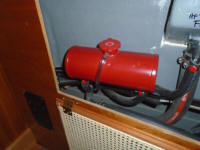
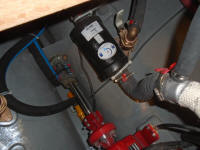
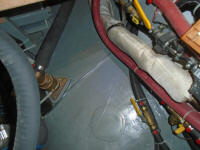
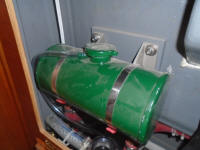
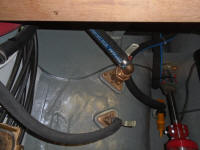
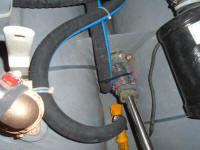 |
In the "this should have been one of the easy jobs"
file, allow me to present the fresh water pump. In
terms of systems commissioning, I figured this one would
be straightforward: put in some water, turn on the
pump => water out the tap. Alas, no.
The first part was easy and effective: with a
hose, I put some fresh water in one of the three new
water tanks. I chose the starboard saddle tank
since it was closest to the water pump, which was
located just above the tank on a shelf.
Next, I turned on the pump. The pump worked, but
would not pump any water. Or, perhaps more
specifically, it would not prime itself, seemingly.
With an advertised dry-prime of 10 feet, it didn't seem
the length of hose before the pump should have been an
issue.
The pump I'd chosen, and which I'd installed some time
back while working on the systems side of things, was a
normal water pressure pump (with built-in pressure
switch) combined with an air tank that was purported to
maintain smooth and even water flow at all volumes.
Reviewing the instructions, I found that the tank was
supposed to be pressurized before use; unhelpfully, the
instructions referred me to the label on the pump tank
itself for more detail about this, since printing them
in the instructions themselves obviously might have
posed serious problems for the manufacturer.
Of course the air valve for the tank was against the
hull, and in my ignorance at the time of installation
I'd not accounted for this. Perhaps I didn't think
I needed the instructions to install something so
straightforward, but that's my cross to bear and I own
full responsibility for that. Regardless, I needed
to access the air valve to check and pressurize the tank
now--at least that seemed like it might be the issue,
given the printed information to pre-pressurize the
tank.
The tank was nestled in its cozy space on a utility
shelf above the starboard tankage space outboard of the
engine room, and was generally well-accessible.
But after removing the screws securing it to the shelf,
I found that various hoses and wiring led above the pump
(apparently after the pump's installation) now limited
how far I could lift up the pump, so I couldn't get it
high enough to lift over the shelf fiddle before it.
Strike two for me. |
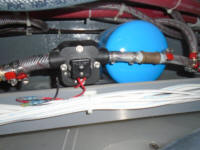 |
To remove the pump, and access the air valve, I undid
the wire bundle running along the fiddle, then cut out a
section of the fiddle, allowing the tank to slide
straight out. Relatively easy and fairly
non-destructive. I'd left enough extra wire to
pull out the assembly and turn it around, accessing the
air valve and helpful labels on the tank and pump. |
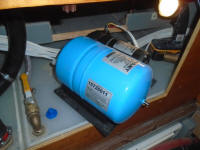
 |
This called for 25 PSI in the tank, which I installed
with an air hose.
Putting the pump back in place and reconnecting the
intake line (which I'd had to remove in order to pull
out the pump), I confidently turned the pump back on,
sure that water would stream in immediately. No:
the same problem. I repeated this process a few
times to be sure the tank had its pressure.
Puzzled (perhaps there are stronger words for my actual
feelings, but that will do), I tried several interim
fixes as they occurred to me, including trying to use
the galley foot pump to prime the line (that wouldn't do
it either), and I even blocked off temporarily the
manual pump line, which by necessity was in the intake
line upstream of the electric pump, to see if that was
affecting the electric pump's ability to self-prime, but
all to no avail.
By now, my artificially-shortened day was coming to a
close, so I had to leave it there for now, unresolved.
My next effort would include pre-priming the supply
lines with a hose, but for that I needed a garden hose
adapter to connect into the various 1/2" water lines on
board, and I didn't have one on hand. Whether this
would solve the issue or not remained to be seen, but
seemed a logical option, if unnecessary (in a global
sense) to my way of thinking. Failing that, I
planned to replace the pump with something else, but I
did hope to avoid that option.
If I sound disgusted by this unforeseen challenge, it's
because I was, and am, all the more so because I
couldn't logically see why this pump couldn't pull water
out of the tank. Perhaps I was trying
to apply logic where logic didn't apply, as I am wont to
do. |
| |
Total Time Today: 3.25 Hours |
<
Previous | Next > |
|
|










